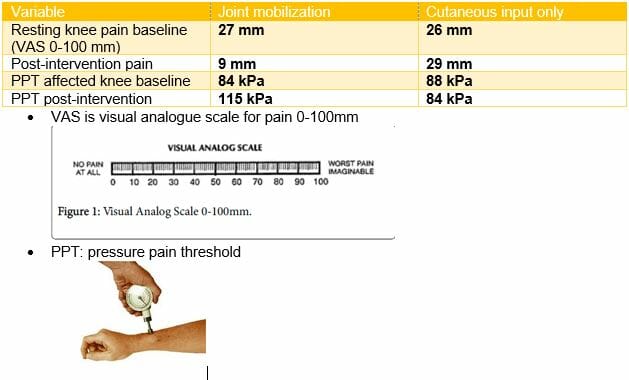Background
Osteoarthritis (OA) is when the cartilage that lines the bone of joints breaks down, causing pain, swelling and problems moving the joint, according to the Arthritis Foundation. OA is the most common chronic condition of the joints, affecting approximately 27 million Americans. OA occurs mostly in the knees, hips, and low back but can occur in any joint. The primary symptom of OA is debilitating pain that leads to impaired function and decreased quality of life. According to Benson et al., knee pain and radiographic evidence of osteoarthritis joint degeneration are not always correlated. Heightened pain from osteoarthritis has two mechanisms. One mechanism is hyperexcitability of central nociceptive pathways (path that sends information to the brain) which has been shown to produce enhanced pain response, spread pain and lead to chronic pain. The second mechanism for heightened pain in individuals diagnosed with osteoarthritis is ineffective pain inhibition. The purpose of this study by Carol et al., was to determine the effect of joint mobilization on impaired conditioned pain modulation (CPM), which is a method of an application of a noxious stimulus at a distant site causes inhibition of pain at the initial site.
Literature search and data analysis to minimize pain in knees with osteoarthritis
In a recent search Carol et al. investigated knee joint mobilizations for pain reduction in individuals that have been diagnosed with osteoarthritis. CPM has been examined through use of protocols that typically include cold or ischemic pain. The effects of surgical and transcutaneous electrical nerve stimulation (TENS) interventions on impaired CPM have been studied, but not manual therapy consisting of joint mobilizations performed by physical therapists to minimize pain from OA in the knees. Carol et al. hypothesized that CPM would be more effective following the application of joint mobilization and the vibratory deficits would normalize following joint mobilization.
Methods
Two experimental groups
- Cutaneous input: hands on cutaneous input only to the knee. This technique was executed by lightly placing both hands on the subject’s knee
- Cutaneous input plus joint mobilization: oscillatory joint mobilizations into slight tissue resistance. Physical therapist placed both hands on knee and glided the tibia forward and back on the femur within a pain-free range, moving slightly into tissue resistance.
Almost all subjects had knee pain in both knees with one knee pain being worse than the other and 85% reported occasions of the knee giving way. All interventions were applied by the same physical therapist, who was fellowship trained in orthopedic manual physical therapy. Experimental condition was applied 2 times for 3 minutes, with a 30 second interval between applications. Pressure pain threshold was established at the experimental knee. The tip of an algometer was applied perpendicular to the most painful site at the medial knee on the affected limb, at a rate of 50 kPa/s, until the subject reported a change from pressure to a painful sensation. The procedure was performed 3 times at 20-second intervals, and the average was calculated to determine PPT. Pressure pain threshold at all 3 sites and resting knee pain were measured preintervention, postintervention, and post-CPM reassessment. Screening protocol for impaired CPM is as follows:
- Subject in supine position with hip and knee flexed 20 degrees
- Most painful site was identified on medial aspect of affected knee and confirmed through gentle palpation by tester
- Pressure pain threshold
Results
No effect was noted from cutaneous input only. The main finding of the current investigation was the impaired CPM was enhanced following application of the joint mobilization intervention. This study suggest joint mobilization enhances CPM in patient with painful OA, demonstrated by decrease in deep tissue sensitivity to pressure. The investigators of this study also found enhanced somatosensory (sensation regarding pressure, pain and warmth) acuity in the knee following joint mobilization.

Physical Therapy First:
Here at Physical Therapy First we provide one on one hands on care for our patients with various diagnoses. Our manually trained physical therapists offer an individualized care plans to assist our patient to achieve their optimal health.
- Courtney, C.A. et al. Joint mobilization enhances mechanisms of conditioned pain modulation in individuals with osteoarthritis of the knee. Journal of Orthopaedic & Sports Physical Therapy. 2016: 46, 168-176
- https://www.arthritis.org/about-arthritis/types/osteoarthritis/what-is-osteoarthritis.php
- https://www.google.com/search?q=visual+analog+scale+mm&safe=active&source=lnms&tbm=isch&sa=X&ved=0ahUKEwjmoMevisvgAhULMd8KHQW8Aq0Q_AUIDigB&biw=1093&bih=514#imgrc=fjN0oJAZyYtSAM:&spf=1550692137843
- https://www.google.com/search?q=algometer&safe=active&source=lnms&tbm=isch&sa=X&ved=0ahUKEwiWjL-PjMvgAhVJGt8KHQU0DRgQ_AUIDygC&biw=1093&bih=514
